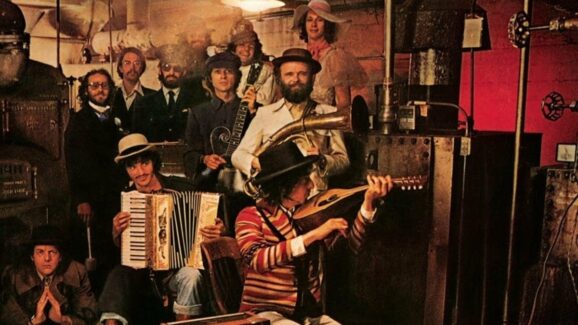The Who’s Odds & Sods (released 10/4/74) is a prime example of how retrospect can reveal more than a little profundity in the work of rock and roll’s most ambitious artists. Stopgap product issued in 1974 as a follow-up to the previous year’s Quadrophenia double album while the band worked on the Ken Russell-directed film of Tommy; what seemed like a motley collection of mostly unreleased tracks is now readily discernible as the very vanguard of vault maintenance as it’s evolved over the years.
Odds & Sods doesn’t just foreshadow titular leader Pete Townshend’s many-splendored (re-) issues of archival endeavors either. It’s also evidence of the wealth of unreleased material in the possession of the Who (and that self-same guitarist/songwriter), duly noted by the man himself in his humorously self-effacing liner notes for the expanded CD. Of course, it didn’t take fifty years of hindsight to reveal that the late John Entwistle actually researched and compiled the anthology.
The Who bassist’s efforts initially amassed enough material to be considered for a double-set, but that concept was dismissed. It reappeared in expanded CD configuration in 1998 and in the vinyl format in 2020. Perhaps not coincidentally, ‘The Ox’ own song, “Postcard” a wry tale of the road comparable to “Success Story” on The Who By Numbers—was the only previously available tune.
It hardly required the perspective of five decades to disclose Odds & Sods as a wealth of rarities, but the expanded version highlights that aspect of this content. Two prominent inclusions of the early Seventies Who repertoire appear in the form of studio versions of “Baby Don’t You Do It” and “Summertime Blues:” like Mose Allison’s “Young Man Blues,” the tunes are familiar from Live At Leeds but are comparatively staid here.
“We Close Tonight” is an outtake from the aforementioned 1973 masterwork, clearly hinting at its themes of adolescent angst. There’s also the homage to the Rolling Stones, a cover of “Under My Thumb,” recorded in 1967 in support of Mick Jagger and Keith Richards after the Glimmer Twins were jailed on trumped-up drug charges.
Then there are some fascinating calls from the 1994 box set 30 Years of Maximum R&B. The grand dynamism of “Glow Girl” presages the now-famous rock opera of 1969, while “Little Billy” is a recording commissioned for an anti-smoking campaign (but never used as such); both hint at the inexorable development of Who music as the tension/release crescendos dominating these pair underscores how, in contrast, group harmony vocals dominated the foursome’s earliest sound and style (hear “Substitute” and “I’m A Boy,” to name just two).
As Keith Moon learned how to apply discipline to his drumming, his playing only grew in its visceral power, particularly as it became more tightly locked with the thunderous, mobile rumble of Entwistle’s instrumental work. Plus, there’s the proportionately restrained and pointed guitar soloing of Townshend on an early version of “Love Ain’t For Keeping” (with Mountain’s Leslie West on guitar behind Pete’s lead voice).
That selection would show up on the Who’s watershed 1971 album, albeit in a different take, and here provides a segue to a depiction of Roger Daltrey’s more greatly nuanced singing. Captured in the same sessions as the preceding cut, the number spells out how the lead vocalist sang so movingly yet without histrionics. To that very end, the sly, witty phrasing he uses on “Put The Money Down” gains impact, knowing the band (successfully) demanded to be paid before taking the stage at Woodstock in August of 1969.
The chronological unfolding of the twenty-three tracks comprising the expansive Odds & Sods also reveals the progression of a streamlined clarity in the Who’s recorded sound, much of which credit should go to engineer/producer Glyn Johns (Beatles, Stones, Eagles, Zeppelin). For instance, the physical impact of “I’m The Face,” the foursome’s first single of 1964 (and an appropriate opening cut here in remixed form) pales compared to the resonance of “Pure And Easy,” the cull from the magnum opus that is Lifehouse (which subsequently begat the landmark LP Who’s Next).
Such cuts as that one illustrate how the evolution of artistry in sonics also mirrored Pete’s increasingly sophisticated songwriting. A number called “Water” only hints at the palpable growth, whereas another stage favorite of that era, “Naked Eye,” encapsulates depth of philosophical thought, in itself a corollary to the firepower of the Who around this juncture of their career: their use of silence (along with sparse interspersions of electric piano) only adds to the eerie atmosphere of the lyrical narrative in combination with the arrangement and performance.
With half a century’s hindsight, it’s tempting to consider there have been way too many anthologies of Who material, especially considering the discerning perspective(s) of Odds & Sods. Whether or not it’s considered a direct companion piece to 1971’s Meaty Beaty Big and Bouncy, this collection accurately represents the sound and style of the volatile British quartet at its most potent over the most prolific arc of its career.









